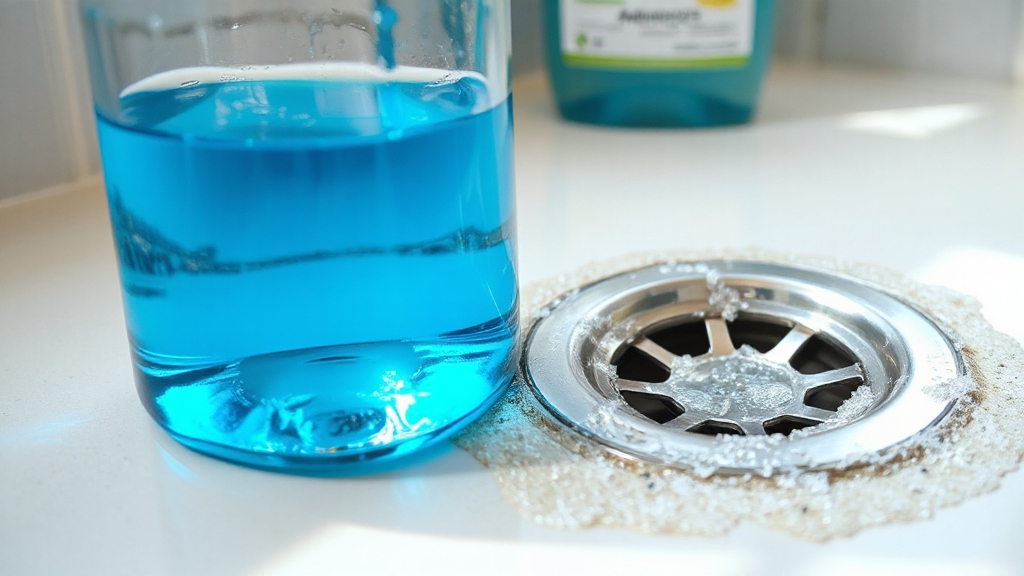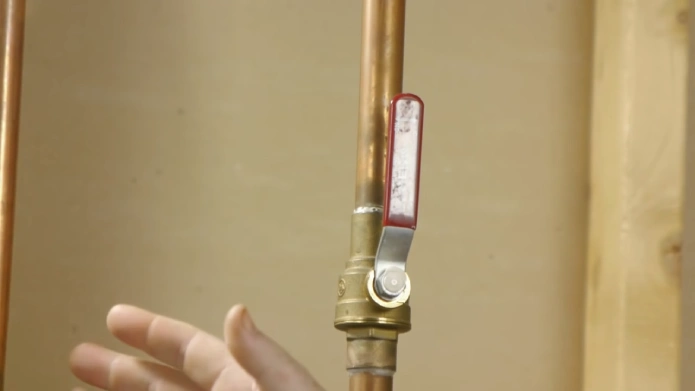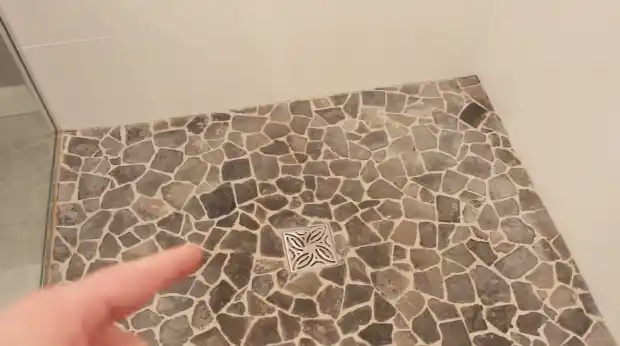Last Updated on July 1, 2025
You can use ammonia to help unclog drains since its alkaline nature breaks down grease and organic debris effectively when diluted with hot water.
Pour it slowly and let it sit for at least 30 minutes before flushing with lukewarm water and using mechanical force like plunging.
However, take safety seriously, use gloves, ventilate well, and never mix with bleach. Ammonia’s risks and safer alternatives are important to contemplate if you want the best results.
Key Takeaways
- Ammonia’s alkaline nature breaks down grease, hair, and organic drain blockages when diluted with hot water.
- A mixture of household ammonia and boiling water applied slowly can soften and help clear clogs within 30 minutes.
- Ammonia is effective mainly on organic material but may not remove solid or mineral-based blockages.
- Using ammonia requires caution due to toxic fumes and risks of pipe corrosion or hazardous chemical reactions.
- Alternative methods like drain snakes or enzyme cleaners may be safer and more effective for stubborn clogs.
How Ammonia Works to Clear Drain Blockages?
Although ammonia is a common household cleaner, its effectiveness in clearing drain blockages comes from its strong alkaline properties that break down organic materials like grease, hair, and food particles.
Ammonia’s powerful alkaline nature effectively breaks down grease, hair, and food debris in clogged drains. When diluted with hot water, ammonia saponifies fats, turning grease into soap-like substances that dissolve and soften clogs.
You’ll need to mix household ammonia at roughly a 1:10 to 1:20 ratio with boiling water and pour it slowly down the drain to ensure it reaches the blockage. This chemical approach is often complemented by mechanical tools such as drain snakes to physically dislodge debris.
Let the solution dwell for at least 30 minutes to allow chemical action to penetrate. It is important to handle ammonia in a well-ventilated area due to its pungent smell and gas nature to ensure safety during use precautions.
Afterward, flushing with lukewarm water and applying mechanical force, such as plunging, helps remove the softened debris. Keep in mind, ammonia weakens blockages chemically but doesn’t physically dislodge them.
Safety Considerations When Using Ammonia
When using ammonia to unclog drains, you must prioritize safety to prevent injury and damage. Ammonia is corrosive and can cause severe skin, eye irritation, and respiratory issues if mishandled.
Always wear protective gloves and goggles, and guarantee adequate ventilation to minimize fume inhalation. Never mix ammonia with bleach or other chemicals to avoid toxic gas production.
Follow these essential safety steps:
- Wear PPE: Gloves and goggles protect against burns and irritation.
- Ventilate: Open windows or use exhaust fans to reduce harmful fumes. Ensuring proper airflow in the work area helps disperse fumes and reduces the risk of inhaling harmful gases. Proper ventilation also helps prevent issues related to air in the system, which can disrupt flow and pressure.
- Dilute Carefully: Mix ammonia with water to lower concentration and protect pipes.
Risks of Using Ammonia in Plumbing Systems
Because ammonia is a reactive and corrosive chemical, using it in plumbing systems carries several significant risks you need to contemplate. Ammonia can react dangerously with residues like chlorine, producing toxic gases.
It also accelerates corrosion in pipes, valves, and seals, leading to leaks or system failures. Overpressure can occur if ammonia accumulates in closed systems, risking damage or rupture.
You must also consider ammonia’s toxicity; inhaling vapors or skin contact can cause severe health issues. Environmental contamination is another concern—leaks can pollute water and soil, harming aquatic life and ecosystems.
Additionally, handling ammonia demands specialized training and equipment to mitigate operational risks. Failing to manage these factors can result in costly repairs, regulatory penalties, and safety hazards.
Consequently, using ammonia in plumbing requires careful evaluation of these risks. Proper ventilation and continuous monitoring with ammonia sensors are critical to preventing hazardous gas accumulation in plumbing environments ammonia sensors.
Moreover, implementing grounding procedures in the plumbing system can help reduce electrical hazards associated with chemical interactions.
Alternative Methods for Unclogging Drains
Since relying on ammonia presents significant risks, exploring alternative methods for unclogging drains is essential. You can choose safer and more effective approaches tailored to clog severity and pipe conditions.
- Mechanical Tools: Use manual or motorized drain snakes to physically break up blockages. Plungers and hair snakes target lighter clogs without damaging pipes, offering immediate relief. Motorized drain snakes operate like long corkscrews to bore into clogs and are more thorough than manual options.
- Hydro Jetting: For stubborn or deep blockages, high-pressure water jets clean pipe interiors and flush debris. This professional method prevents recurring clogs by removing buildup thoroughly.
- Chemical and Natural Cleaners: Baking soda with vinegar or enzymatic cleaners digest organic matter gently. Avoid harsh chemicals that risk pipe corrosion and environmental harm.
Best Practices for Maintaining Clear Drains
Although drains may seem low-maintenance, you’ll guarantee clear pipes and prevent costly repairs by adopting consistent cleaning routines and educating everyone in your household about proper drain use.
Regularly clean sink traps and use drain screens to block debris. Flush drains with hot water to dissolve grease buildup, and avoid disposing of non-degradable or bulky items. Preventative care minimizes the need for costly repairs and extensive drain cleaning.
Additionally, understanding the role of pressure-balancing valves in maintaining consistent water flow can help prevent sudden temperature changes that might affect drain usage.
Educate household members on what not to flush, posting reminders near sinks. Manually remove hair and debris, use enzyme-based cleaners, and avoid harsh chemicals to preserve pipe integrity. Properly dispose of cooking oils outside drains and monitor for slow drainage as an early warning sign.
Schedule annual professional inspections and cleanings to detect issues early, and address unusual sounds or slow drains promptly to maintain excellent plumbing performance.
Frequently Asked Questions
Can Ammonia Be Used on All Types of Drain Clogs?
You can use ammonia on drain clogs caused by organic buildup like soap scum, grease, and food particles, but it’s not effective on solid blockages such as dense hair mats or foreign objects.
Avoid using it on metal pipes or septic systems due to corrosion and bacterial disruption risks. Always dilute ammonia, ensure good ventilation, and never mix it with bleach.
How Long Should Ammonia Sit in the Drain Before Rinsing?
Imagine you poured diluted ammonia down your kitchen sink clogged with grease buildup. You should let it sit for about 30 minutes to effectively break down the organic material. During this time, don’t use the sink to allow ammonia to work.
After 30 minutes, rinse the drain with lukewarm or cold water to flush out loosened debris. Repeat if needed, but avoid frequent use to prevent pipe damage and toxic fume risks.
Is Ammonia Safe for Septic Tanks and Wastewater Systems?
You shouldn’t use ammonia in septic tanks or wastewater systems because it’s toxic to the beneficial bacteria that break down waste. Excess ammonia raises biological oxygen demand and can disrupt microbial activity, harming system performance.
It also forms corrosive compounds that damage infrastructure. To protect your system and comply with regulations, avoid ammonia-based products and opt for septic-safe cleaners that maintain microbial balance and prevent harmful overloads.
Can Ammonia Damage Plastic or PVC Drain Pipes?
Think of ammonia as a cautious guest in your PVC pipes, it generally won’t wreck the place but can cause trouble if left too long or in high doses.
You won’t usually see chemical damage because PVC resists ammonia well, especially at low concentrations. However, repeated or concentrated exposure might weaken the pipes.
What Should I Do if Ammonia Causes a Bad Odor in Drains?
If ammonia causes a bad odor in your drains, first ventilate the area by opening windows and doors. Then, flush the drain thoroughly with cold water to remove residual ammonia. Repeat flushing if the smell persists.
Avoid mixing ammonia with other chemicals to prevent toxic fumes. Use mechanical tools like a plunger or drain snake to clear blockages. Consider safer alternatives like enzymatic cleaners to prevent future odors and pipe damage.
Keep Your Drains Happy with Some Simple Everyday Habits
Ammonia can break down grease and grime to help clear minor drain blockages, but it demands caution, proper ventilation, and never mixing with bleach. You risk damaging pipes and creating toxic fumes.
Instead, consider enzyme cleaners, mechanical plungers, or natural solutions like baking soda and vinegar.
To keep drains flowing smoothly, clean regularly, avoid pouring grease down the sink, and address slow drains promptly. Use ammonia wisely, safely, and selectively for best results.



